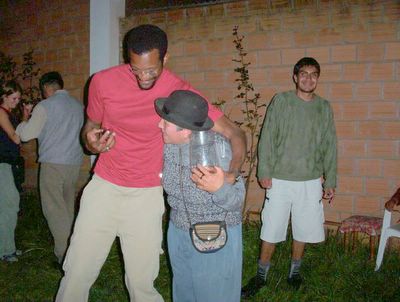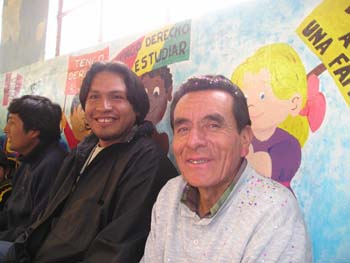Puno, Peru (3/18/04 - 3/31/04)
“Like what?” I ask.
“Like 24 ounce curls!” (drinking).
“You have 2 dogs,” I’m trying to confirm.
“No, we have 3, but we let Benjamin (the brother who is not present) eat at the table.”
This was the best host family stay I’ve ever had (and I’ve lived with scores on a few continents, so that’s saying a lot). They were always smiling, laughing and joking. The mother, Dona Judith was a great cook and fed me enormous plates of traditional Peruvian dishes. She’s about 4’10” and light enough to be considered white by US standards, but something about her love of laughter and her jovial spirit reminded me of my real mother who, needles to say, is African American, and stands 5’11” “and three quarters,” as she would say.

Dancing with my host mom, Dona Judith

The second day there we head to Chucuito for some sight seeing. On our way there, as they’re explaining that the woman is supposed to sit down if a married couple wants a boy and the man should sit if they want a girl, I’m thinking to myself “How do they know the ancient temple was dedicated to fertility? And where are people supposed to sit?”
Everything makes sense as soon as we enter the temple ruins. There are giant stone penises (4 feet high by 1.5 feet in diameter) all over the place! Natasha, my co-leader took a photo of herself hugging a taller one. I took no photos, and didn’t sit anywhere within the FENCE that surrounded the ancient site. I’m all for new experiences, but I’m not trying to be a father any time soon, and I have no desire to hug giant penises.
We were in Puno to complete a community service project at a local “jardin” (kindergarten) serving 146 of the city’s poorest children. Their play space was a nondescript area painted in drab monotone colors. We were asked to paint educational murals on the walls and floor.
Some of the professors had stenciled shapes and numbers, as well as cartoon figures from books on the floor and walls. All said and done, we not only added tons of vibrant colors to the initial play space, but we made multicolored hopscotch boards (mine had red, black, green and gold as the primary colors.) to the floors and painted murals all over the hall and stairwell.
The first thing I painted was the African boy holding the sign that read “We have the right to study” on the wall on which was stenciled international children holding signs proclaiming children’s rights. I didn’t want anyone else to misrepresent the only Back representation on the wall. As I’m painting him and realizing that most of the images on the wall are of white children found in the outdated used books that our countrymen have exported to less fortunate schools in developing countries, I’m contemplating just how I plan to bring up the issue with the group. Is it even worth bringing up race related issues to a bunch of blond haired blue eyed rich kids who probably can’t relate anyway?
The cool thing was that after 2 of them saw me painting my kid, they took it upon themselves to change the ethnicities of a couple of the other kids to shades of brown.
Even cooler was Alexis coming to me with tears in her eyes upset because under the caption “Our Family” was a family of 5 that looked more Caucasian than most Peruvians. “None of these kids look like that!” she protested. “Our government has been responsible for so much mal-intent in this part of the world, and I don’t want to be a part of that tradition!” Alexis became conscious of such issues after reading Tony Morrison’s The Bluest Eye, and was now asking me how she could bring it up to the group (God works in mysterious ways). Despite the fact that there really weren’t anymore human figures left to be painted on the walls, I coached her through her approach to the group. A couple of them became defensive about the fact that they had painted their figures blond and blue, but the majority of the group understood the importance of surrounding children with images that look like them after she and I concluded the session. The final result? We talked to the teachers about creating a mural with a Peruvian theme. And Alexis and I did the majority of the painting of the mural that was added late. But it’s big, bright and beautiful in the main entrance to the jardin! (Unfortunately I don’t have a copy of that photo with me, so you’ll have to make do with these makeshift before and after photos…)

El Jardin (before), Puno, Peru


Marco Antonio @ El Jardin (after)

I was thinking that since I’ll be doing a 4 day hike at an elevation over 10,000 feet in a couple of weeks, playing soccer at 13,000 feet may be a good way to “train.” In fact, it wouldn’t have been a bad idea had I been playing with my group (young, but relatively unskilled soccer players who are just as sluggish as I am at this altitude). You know how football commentators are always elaborating on how difficult it is for teams to play in the thin air at Mile High Stadium? Well Mile High Stadium is at an elevation of less than 6,000 feet. See where I’m going with this? Playing soccer at 13,000 feet with a bunch of 20 year old players who grew up playing at this elevation was NOT a good idea!
Playing for 2.5 hours was probably a worse idea. It felt like someone was standing on my chest most of the game. I had never felt so out of breath in my life! They play soccer here like some brothers play basketball in the city. The teams put money on the game, and the winning team stays on the court (it’s pretty fast paced as the soccer field is actually on the basketball court). Unfortunately (because I really didn’t feel like playing after busting a lung in the first 5 minutes), our team won our first and second games. After the first game I told them that I had NO problem with them substituting another player for me, but they wouldn’t let me leave. While I made a little money on the deal, I could hardly walk or breathe 2.5 hours later.


0 Comments:
Post a Comment
<< Home